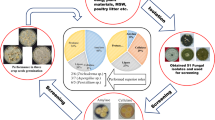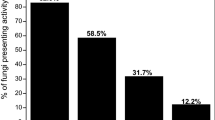Abstract
Today, many microbial amylases are available commercially and they have almost completely replaced chemical hydrolysis in several industry processes. Amylases from microorganisms have a broad spectrum of industrial applications as they are more stable than amylases obtained from plants and animals. The objective of this work was to use potato baits in an Atlantic Forest remnant located in Ribeirão Preto, São Paulo, Brazil, in order to obtain amylase-producing fungi with potential for biotechnological application. In addition, the culture conditions for the fungal strain that presented higher production of glucoamylase were standardized using industrial wastes. For this, 6 PET bottles containing potatoes as baits were scattered at different points in an Atlantic forest remnant. After 6 days, the samples were collected, and the filamentous fungi were isolated in Petri dishes. Fungi screening was carried out in Khanna liquid medium with 1% starch Reagen®, at 30 °C, pH 6.0, under static conditions for 4 days. Proteins and glucoamylase activity were determined by Bradford and 3,5-dinitrosalicylic acid (DNS), respectively. Among all isolated fungi, A. carbonarius showed the highest glucoamylase production. Its best cultivation conditions were observed in Khanna medium, 4 days, at 30 °C, pH 6.0, under static condition with 0.1% yeast extract and 1% starch Reagen®. Wheat and brewing residues were also used as inducers for large quantities of glucoamylase production. A. carbonarius showed to be a good alternative for the wheat and brewing waste destinations in order to obtain high added value products.







Similar content being viewed by others
References
Abarca ML, Accensi F, Cano J, Cabañes FJ (2004) Taxonomy and significance of black aspergilli. Antonie van Leeuwenhoek 86:33–49
Alegre ACP, Polizeli MLTM, Terenzi HF, Jorge JA, Guimarães LHS (2009) Production of thermostable invertases by Aspergillus caespitosus under submerged or solid-state fermentation using agroindustrial residues as carbon source. Braz J Microbiol 40:612–622
Almeida PZ, Pereira MG, Carvalho CC, Heinen PR, Ziotti LS, Messias JM, Jorge JA, Polizeli MLTM (2017) Bioprospection and characterization of the amylolytic activity by filamentous fungi from Brazilian Atlantic Forest. Biota Neotrop 17:e20170337
Alonso V, Cavaglieri L, Ramos AJ, Torres A, Marin S (2017) Modelling the effect of pH and water activity in the growth of Aspergillus fumigatus isolated from corn silage. J Appl Microbiol 122:1048–1056
Amadi OC, Okolo BN (2012) Characterization of morphological forms of Aspergillus carbonarius and the effect of inoculum size on raw starch digesting amylase (RSDA) production. Afr J Microbiol Res 6:1934–1941
Balajee SA, Baddley JW, Peterson SW, Nicke D, Varga J, Boey A, Lass-Flörl C, Frisvad JC, Samson RA (2009) Aspergillus alabamensis, a new clinically relevant species in the section Terrei. Eukaryot Cell 8:713–722
Benassi VM, Pasin TM, Facchini FDA, Jorge JA, Polizeli MLTM (2014) A novel glucoamylase activated by manganese and calcium produced in submerged fermentation by Aspergillus phoenicis. J Basic Microbiol 54:333–339
Bharathiraja S, Suriya J, Krishnan M, Manivasagan P, Kim SK (2017) Production of enzymes from agricultural wastes and their potential industrial applications. Adv Food Nutr Res 80:125–148
Bradford MM (1976) A rapid and sensitive for the quantitation of microgram quantities of protein utilizing the principle of protein-dye binding. Anal Biochem 72:248–254
Domsch KH, Gams W, Anderson TH (2007) Compendium of soil fungi. IHW-Verlag, Eching
Egorova K, Antranikian G (2005) Industrial relevance of thermophilic archaea. Curr Opin Microbiol 8:649–655
Emerson R (1941) An experimental study of the life cycles and taxonomy of Allomyces. Lloydia 4:77–144
Ferreira-Nozawa MS, Rezende JL, Guimarães LHS, Terenzi HF, Jorge JA, Polizeli MLTM (2008) Mycelial glucoamylases produced by the thermophilic fungus Scytalidium thermophilum strains 15.1 and 15.8: purification and biochemical characterization. Braz J Microbiol 39:344–352
Firn RD (2003) Bioprospecting—why is it so unrewarding? Biodivers Conserv 12:207–216
Fontana JD, Gebara M, Blumel M, Schneider H, Mackenzie CR, Johnson KG (1988) α-4-O-methyl-D-glucuronidase component of xylanolytic complexes. Methods Enzymol 160:560–571
Heinen PR, Pereira MG, Rechia CGV, Almeida PZ, Monteiro LMO, Pasin TM, Messias JM, Cereia M, Kadowaki MK, Jorge JA, Polizeli MLTM (2017) Immobilized endo-xylanase of Aspergillus tamarii Kita: an interesting biological tool for production of xylooligosaccharides at high temperatures. Process Biochem 53:145–152
Hwang SY, Nakashima K, Okai N, Okazaki F, Miyake M, Harazono K, Ogino C, Kondo A (2014) Thermal stability and starch degradation profile of α-amylase from Streptomyces avermitilis. Biosci Biotechnol Biochem 77:2449–2453
Khanna P, Sundari SS, Kumar NJ (1995) Production, isolation and partial purification of xylanase from Aspergillus sp. World J Microbiol Biotechnol 11:242–243
Madigan M, Martinki JM, Parker J (2003) Brock biology of microorganisms, 10th edn. Prentice Hall, NJ
Maki CS, Teixeira FF, Paiva E, Paccolameirelles LD (2001) Analyses of genetic variability in Lentinula edodes through mycelia responses to different abiotic conditions and RAPD molecular markers. Braz J Microbiol 32:170–175
Marín D, Linde D, Lobato MF (2006) Purification and biochemical characterization of an α-glucosidase from Xanthophyllomyces dendrorhus. Yeast 23:117–125
Miller GL (1959) Use of dinitrosalicylic acid reagent for determination of reducing sugar. Anal Chem 31:426–428
Mittermeier RA, Da Fonseca GAB, Rylands AB, Brandon K (2005) A brief history of biodiversity conservation in Brazil. Conserv Biol 19:601–607
Mussatto SI (2009) Biotechnological potential of brewing industry by-products. In: Singh nee’ Nigam P, Pandey A (eds) Biotechnology for agro-industrial residues utilization. Springer, Dordrecht
Negi S, Banerjee R (2010) Optimization of culture parameters to enhance production of amylase and protease from Aspergillus awamori in a single fermentation. Afr J Biochem Res 4:73–80
Onofre SB, Groff SA, Sartori A, Bertolini J, Kagimura FY, Rotta D, Mazzali L, Steilmann P (2012) Production of α-amylase and amyloglucosidase by the fungus Cylindrocladium sp. in semi-solid-state fermentation. J Microbiol Res 2:123–126
Pasin TM, Benassi VM, Moreira EA, Jorge JA, Polizeli MLTM (2014) Prospecting filamentous fungi for amylase production: standardization of Aspergillus japonicus culture conditions. Br Biotechnol J 4:2231–2927
Pasin TM, Benassi VM, Heinen PR, Damasio ARL, Cereia M, Jorge JA, Polizeli MLTM (2017) Purification and functional properties of a novel glucoamylase activated by manganese and lead produced by Aspergillus japonicus. Int J Biol Macromol 102:779–788
Rizzatti ACS, Jorge JA, Terenzi HF, Rechia CGV, Polizeli MLTM (2001) Purification and properties of a thermostable extracellular β-D-xylosidase produced by thermotolerant Aspergillus phoenicis. J Ind Microbiol Biotechnol 26:156–160
Sethi BK, Dikshit B, Sahoo SL, Pradhan C, Sena S, Behera BC (2017) Extracellular production of amylase and protease by Penicillium Purpurogenum BKS9. Biosci Bioeng 5:1–6
Shafique S, Bajwa R, Shafique S (2010) Mutagenesis and genetic characterization of amylolytic Aspergillus niger. Nat Prod Res 12:1104–1114
Silva TM, Michelin M, Damasio ARL, Maller A, Almeida FB, Ruller R, Ward RJ, Rosa JC, Jorge JA, Terenzi HF, Polizeli MLTM (2009) Purification and biochemical characterization of a novel alpha-glucosidase from Aspergillus niveus. Antonie van Leeuwenhoek 96:569–578
Sinha M, Sørensen A, Ahamed A, Ahring BK (2015) Production of hydrocarbons by Aspergillus carbonarius ITEM 5010. Fungal Biol 119:274–282
Tabarelli M, Aguiar AV, Ribeiro MC, Metzger JP, Peres CA (2010) Prospects for biodiversity conservation in the Atlantic Forest lessons from aging human-modified landscapes. Biol Conserv 143:2328–2340
Vaidya S, Srivastava PK, Rathore P, Pandey AK (2015) Amylases: a prospective enzyme in the field of biotechnology. J Appl Biosci 41:1–18
Vogel HF (1964) Distribution of lysine pathway among fungi: evolutionary implications. Am Nat 98:435–446
Wang S, Lin C, Liu Y, Shen Z, Jeyaseelan J, Qin W (2016) Characterization of a starch-hydrolyzing α-amylase produced by Aspergillus niger WLB42 mutated by ethyl methanesulfonate treatment. Int J Biochem Mol Biol 1:1–10
Weyda I, Lübeck M, Ahring BK, Lübeck PS (2014) Point mutation of the xylose reductase (XR) gene reduces xylitol accumulation and increases citric acid production in Aspergillus carbonarius. J Ind Microbiol Biotechnol 41:733–739
Wiseman A (1975) Handbook of enzyme biotechnology. Wiley, p 148
Yang L, Lübeck M, Lübeck PS (2014) Deletion of glucose oxidase changes the pattern of organic acid production in Aspergillus carbonarius. AMB Express 4:1–9
Yang L, Lübeck M, Lübeck PS (2015) Effects of heterologous expression of phosphoenolpyruvate carboxykinase and phosphoenolpyruvate carboxylase on organic acid production in Aspergillus carbonarius. J Ind Microbiol Biotechnol 42:1533–1545
Zhang H, Wang S, Zhang XX, Ji W, Song F, Zhao Y, Li J (2016) The amyR-deletion strain of Aspergillus niger CICC2462 is a suitable host strain to express secreted protein with a low background. Microb Cell Factories 28:15–68
Acknowledgments
We thank Mariana Cereia for English support and Mauricio de Oliveira for technical assistance.
Funding
This work was supported by grants from Fundação de Amparo à Pesquisa do Estado de São Paulo (FAPESP), Conselho Nacional de Desenvolvimento Científico e Tecnológico (CNPq), and the National System for Research on Biodiversity (Sisbiota-Brazil, CNPq 563260/2010-6 and FAPESP n°. 52322-3/2010). This project was partly financed by the National Institute of Science and Technology of the Bioethanol (no. 574002/2008-1) and Coordenação de Aperfeiçoamento de Pessoal de Nível Superior - Brazil (CAPES) - Finance Code 001. TMP and VMB were recipients of FAPESP fellowship (no. 24948-0/2012 and 52693-4/2009). EAM was a recipient of PIBIC/CNPq fellowship. RCL is a recipient of PNPD/CAPES fellowship, LSZ was a recipient of CNPq fellowship, and MLTMP is a productivity research fellow of CNPq (301963/2017-7).
Author information
Authors and Affiliations
Corresponding author
Ethics declarations
Conflict of interest
The authors declare that they have no conflicts of interest.
Ethics statement
No animals or humans were used in this study.
Additional information
Publisher’s note
Springer Nature remains neutral with regard to jurisdictional claims in published maps and institutional affiliations.
Rights and permissions
About this article
Cite this article
Pasin, T.M., dos Anjos Moreira, E., de Lucas, R.C. et al. Novel amylase-producing fungus hydrolyzing wheat and brewing residues, Aspergillus carbonarius, discovered in tropical forest remnant. Folia Microbiol 65, 173–184 (2020). https://doi.org/10.1007/s12223-019-00720-4
Received:
Accepted:
Published:
Issue Date:
DOI: https://doi.org/10.1007/s12223-019-00720-4




